Coquina and Eclogite
Definition
Definition
Coquina is a sedimentary rock that is composed either wholly or almost entirely of the transported, abraded, and mechanically-sorted fragments of the shells of molluscs, trilobites, brachiopods, or other invertebrates
Eclogite is an extreme metamorphic rock, formed by regional metamorphism of basalt rock under very high pressure and temperature
History
Origin
European Foreland Basins
Unknown
Discoverer
Unknown
René Just Haüy
Etymology
From Concha (Latin)+ Coquina(Spanish) +conch(English)= Couquina (mid 19th century)
From French, Greek eklogē selection with reference to the selective content of the rock + -ite1
Class
Sedimentary Rocks
Metamorphic Rocks
Sub-Class
Durable Rock, Soft Rock
Durable Rock, Medium Hardness Rock
Family
Group
Not Applicable
Not Applicable
Other Categories
Coarse Grained Rock, Opaque Rock
Fine Grained Rock, Opaque Rock
Texture
Texture
Clastic
Earthy
Color
Beige, Buff, Orange
Black, Brown, Colourless, Green, Grey, Pink, White
Maintenance
More
Less
Durability
Non-Durable
Durable
Water Resistant
No
No
Scratch Resistant
No
Yes
Stain Resistant
No
Yes
Wind Resistant
No
Yes
Acid Resistant
No
No
Appearance
Layered, Banded, Veined and Shiny
Dull, Banded and Foilated
Uses
Architecture
Interior Uses
Decorative Aggregates, Homes, Hotels, Interior Decoration
Decorative Aggregates, Interior Decoration
Exterior Uses
Garden Decoration, Office Buildings
Paving Stone, Garden Decoration
Other Architectural Uses
Curbing
Curbing
Industry
Construction Industry
Building houses or walls, Construction Aggregate
Not Yet Used
Medical Industry
Not Yet Used
In Chemical and Pharmaceutical Industry, Medicines and Cosmetics
Antiquity Uses
Artifacts, Monuments, Sculpture, Small Figurines
Artifacts
Other Uses
Commercial Uses
Creating Artwork
Creating Artwork, Gemstone
Types
Types
Not Available
Not Available
Features
Available in Lots of Colors and Patterns, Is one of the oldest rock
Available in Lots of Colors and Patterns, Generally rough to touch, Is one of the oldest rock
Archaeological Significance
Monuments
Used
Not Yet Used
Famous Monuments
Data Not Available
Not Applicable
Sculpture
Used
Not Yet Used
Famous Sculptures
Data Not Available
Not Applicable
Pictographs
Used
Used
Petroglyphs
Used
Used
Figurines
Used
Not Yet Used
Fossils
Present
Absent
Formation
Formation
Coquina is a sedimentary rock which is formed when billions of small clam-like seashell, called Coquina, or cockleshell are die and hence are deposited, buried and turns into a rock when pressure is applied.
Eclogite forms from high-pressure metamorphism of mafic igneous rocks mainly, basalt or gabbro as it plunges into the mantle in a subduction zone.
Composition
Mineral Content
Apatite, Augite, Bronzite, Calcite, Chert, Chlorite, Clay Minerals, Epidote, Feldspar, Garnet, Micas, Muscovite or Illite
Amphibole, Coesite, Corundum, Dolomite, Garnet, Kyanite, Lawsonite, Paragonite, Phengite, Pyroxene, Quartz, Rutile, Zoisite
Compound Content
CaO, Carbon Dioxide, Iron(III) Oxide, MgO
Aluminium Oxide, NaCl, CaO, Carbon Dioxide, Iron(III) Oxide, Magnesium Carbonate, MgO, Sodium Oxide, Potassium, Sodium
Transformation
Metamorphism
No
No
Types of Metamorphism
Not Applicable
Not Applicable
Weathering
Yes
Yes
Types of Weathering
Biological Weathering, Chemical Weathering, Mechanical Weathering
Mechanical Weathering
Erosion
Yes
Yes
Types of Erosion
Coastal Erosion, Sea Erosion, Water Erosion, Wind Erosion
Chemical Erosion, Sea Erosion
Properties
Physical Properties
Hardness
1-2
3.5-4
Grain Size
Coarse Grained
Fine Grained
Fracture
Irregular
Not Available
Streak
White
White
Porosity
Highly Porous
Less Porous
Luster
Dull to Vitreous to Submetallic
Subvitreous to Dull
Cleavage
Not Available
Perfect
Toughness
Not Available
Not Available
Specific Gravity
1.10-2.24
2.86-2.87
Transparency
Opaque
Opaque
Density
2.8-2.9 g/cm3
3.2-3.6 g/cm3
Thermal Properties
Resistance
Heat Resistant, Impact Resistant, Pressure Resistant, Wear Resistant
Heat Resistant
Reserves
Deposits in Eastern Continents
Asia
Not Yet Found
India, Kazakhstan, Kuwait, Russia, South Korea, Thailand, Turkey
Africa
Not Yet Found
Ethiopia, Morocco, South Africa
Europe
United Kingdom
France, Germany, Italy, Norway, Scotland
Others
Not Yet Found
Greenland
Deposits in Western Continents
North America
USA
Canada, Costa Rica, Panama, USA
South America
Not Yet Found
Argentina, Brazil, Colombia, Ecuador
Deposits in Oceania Continent
Australia
Not Yet Found
Central Australia, New Zealand, Queensland
All about Coquina and Eclogite Properties
Know all about Coquina and Eclogite properties here. All properties of rocks are important as they define the type of rock and its application. Coquina belongs to Sedimentary Rocks while Eclogite belongs to Metamorphic Rocks.Texture of Coquina is Clastic whereas that of Eclogite is Earthy. Coquina appears Layered, Banded, Veined and Shiny and Eclogite appears Dull, Banded and Foilated. The luster of Coquina is dull to vitreous to submetallic while that of Eclogite is subvitreous to dull. Coquina is available in beige, buff, orange colors whereas Eclogite is available in black, brown, colourless, green, grey, pink, white colors. The commercial uses of Coquina are creating artwork and that of Eclogite are creating artwork, gemstone.
|
||
|
||
|










